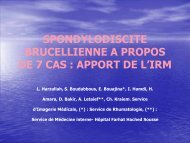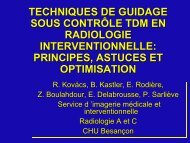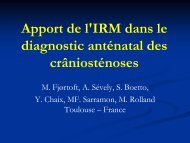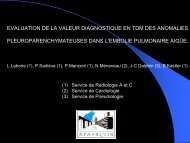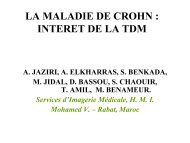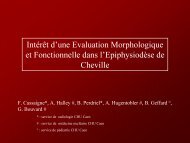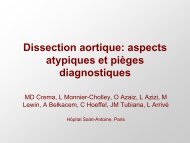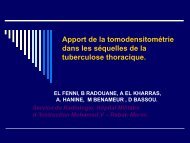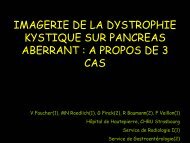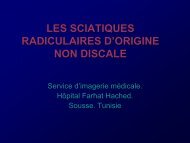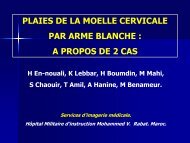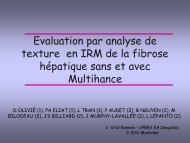Anévrysmes de l'artère rénale : exploration multimodale et revue de ...
Anévrysmes de l'artère rénale : exploration multimodale et revue de ...
Anévrysmes de l'artère rénale : exploration multimodale et revue de ...
You also want an ePaper? Increase the reach of your titles
YUMPU automatically turns print PDFs into web optimized ePapers that Google loves.
Anévrysmes<br />
<strong>de</strong> l'artère re rénale r<br />
:<br />
<strong>exploration</strong> <strong>multimodale</strong> <strong>et</strong> <strong>revue</strong> <strong>de</strong> la<br />
littérature<br />
IG Lupescu, M Lesaru, R Capsa,<br />
M Ghinea, M Grasu, SA Georgescu<br />
Bucarest - Roumanie
Introduction<br />
Les anévrismes <strong>de</strong> l’artère rénale sont une entité rare, l’inci<strong>de</strong>nce l<br />
varie entre 0,03 <strong>et</strong> 1%.<br />
Les localisations extraparenchymateux sont dominantes (85% cas)<br />
par rapport aux localisations intraparenchymateux. 70% <strong>de</strong>s<br />
anévrysmes sont <strong>de</strong> type sacculiformes, 20% fusiformes <strong>et</strong> 10%<br />
disséquant.<br />
La plus part <strong>de</strong>s anévrismes rénales sont asymptomatiques <strong>et</strong> <strong>de</strong><br />
découverte fortuite.<br />
L’imagerie est essentielle pour le bilan pr<strong>et</strong>hérapeutique <strong>et</strong> le suivi au<br />
long du temps.<br />
Objectif<br />
Le but <strong>de</strong> notre travail est <strong>de</strong> démontrer l’apport complémentaire <strong>de</strong>s<br />
différentes métho<strong>de</strong>s d’imagerie dans le bilan pr<strong>et</strong>hérapeutiques <strong>de</strong>s<br />
anévrismes <strong>de</strong> l’artère rénale.
Matériel <strong>et</strong> métho<strong>de</strong>s<br />
Nous présentons 3 cas (femmes agées<br />
<strong>de</strong> 32, 45 <strong>et</strong> 54 ans),<br />
d’anévrismes <strong>de</strong> l’artère rénale droite hospitalisées pour:<br />
le bilan d’hypertension artérielle (2 <br />
cas)<br />
douleurs lombaires (1 ( 1 cas)<br />
l’évaluation d’une d<br />
symptomatologie biliaire (1 cas).<br />
<br />
<br />
Les 3 cas ont été explorées par:<br />
échographie standard <strong>et</strong> echo-Doppler<br />
<br />
(ATL- Philips);<br />
TDM (Somatom Plus- Siemens) <strong>et</strong> IRMI<br />
<br />
(Horizon LX- General<br />
Electric) sans <strong>et</strong> avec injection;<br />
2 cas ont bénéficié d’une<br />
artériographie sélective (Siemens) utilisée <br />
comme gold<br />
standard <strong>de</strong>s artères rénales pour mieux visualiser les rapports<br />
entre les anévrismes <strong>et</strong> la bifurcation <strong>de</strong> l’artère rénale.
Matériel <strong>et</strong> métho<strong>de</strong>s<br />
La TDM a compris <strong>de</strong>s coupes natives <strong>et</strong> avec contraste iv<br />
nonionique en acquisition spirale (collimation-3mm, pitch-1, in<strong>de</strong>x <strong>de</strong><br />
reconstruction-1mm).<br />
L’IRM a été réalisée sur une machine <strong>de</strong> 1,5T utilisant <strong>de</strong>s coupes<br />
en pondération T2 FSE avec suppression <strong>de</strong> graisse (FS) <strong>et</strong> SSFSE<br />
avec TE court, <strong>de</strong>s coupes T1 FSPGR sans <strong>et</strong> avec contraste (Gd-<br />
DTPA) <strong>et</strong> une acquisition angio-MR <strong>de</strong> type 3D FSPGR avec Gado<br />
associée à une ARM <strong>de</strong> type Phase Contrast (PC). Posttraitement :<br />
reconstructions MIP <strong>et</strong> MPR .<br />
L’artériographie sélective a été réalisée par la métho<strong>de</strong> Seldinger,<br />
er,<br />
avec une <strong>exploration</strong> sélective <strong>de</strong>s artères rénales .
Résultats<br />
Dans le 1-èr 1 r cas on a mis en évi<strong>de</strong>nce l’existence d’un double<br />
anévrisme <strong>de</strong> l’artère rénale droite dont le premier volumineux<br />
(diamètre axial <strong>de</strong> 8,8 cm) partiellement thrombosé localisée à<br />
distance <strong>de</strong> l’ostium <strong>de</strong> l’artère re rénale <strong>et</strong> le <strong>de</strong>uxième <strong>de</strong> p<strong>et</strong>ite taille<br />
(diamètre axial <strong>de</strong> 9 mm) en contiguïté avec le première anévrisme.<br />
Dans le 2-ème cas l’anévrisme a été localisée au niveau du sinus<br />
rénal droit sur la bifurcation <strong>de</strong> l’artere rénale droite (diamètre axiale<br />
<strong>de</strong> 2,6 cm).<br />
Dans le 3-ème cas il s’agissait s<br />
d’une d<br />
découverte d<br />
fortuite après<br />
l’angioscanner <strong>de</strong> <strong>de</strong>ux anévrismes <strong>de</strong> l’artere l<br />
rénale r<br />
droite (diamètre<br />
axiale <strong>de</strong> 3,2 cm <strong>et</strong> <strong>de</strong> 8 mm).<br />
Dans les premièrs<br />
rs 2 cas présentées es les patientes ont été opérées, la<br />
néphrectomie étant considérée comme la métho<strong>de</strong> chirurgicale <strong>de</strong><br />
choix.
1-èr cas: F, 54 ans<br />
Symptomatologie clinique:<br />
- hypertension artérielle<br />
- douleurs lombaires<br />
Echographie<br />
Image ron<strong>de</strong>, hétérogène dont la partie<br />
supérieure est hipoecogene est la partie<br />
inférieure est ecogene localisée au niveau<br />
du sinus rénal droit.<br />
Le Doppler montre une flux turbulent,<br />
<strong>de</strong> type artérielle qu niveau <strong>de</strong> la lésion.
1-èr cas<br />
T2 FSE<br />
IRM<br />
Volumineuse lésion arrondie <strong>de</strong> signal hétérogène T2 <strong>et</strong> T1 après Gado avec une<br />
partie circulante <strong>et</strong> une partie thrombosé proj<strong>et</strong>é au niveau du sinus rénal droit <strong>et</strong><br />
p<strong>et</strong>ite image additionnelle localisée au niveau <strong>de</strong> la partie postérieure <strong>de</strong> l’ARD.<br />
T1 FSPGR après Gd
1-èr cas<br />
ARM 3D FSPGR avec Gadolinium<br />
en phases multiples<br />
Visualisation <strong>de</strong> la partie circulante <strong>et</strong> thrombosé <strong>de</strong><br />
l’anévrisme <strong>et</strong> <strong>de</strong> ses rapports avec le pédicule rénal
1-èr cas<br />
Artériographie selective <strong>de</strong> l’artère rénale droite<br />
Double anévrisme <strong>de</strong> l’artère rénale droite,<br />
dont un volumineux <strong>et</strong> partiellement circulant
1-èr cas<br />
Aspect intraoperatorie<br />
(Prof.Dr. I. Sinescu)<br />
Aspect macroscopique <strong>de</strong> l’anévrisme rénal<br />
thrombosé après exerese du rein droit<br />
Aspect histopathologique au niveau <strong>de</strong>s parois <strong>de</strong> l’anévrisme thrombosé<br />
(Dr. M.Hortopan)
2-ème cas: F, 32 ans<br />
Clinique: crises d’hypertension artérielle<br />
SSFSE TE court<br />
T2 FSE FS<br />
Scanner après injection du PCINI<br />
Image ron<strong>de</strong> qui se rehausse intensivement après injection <strong>de</strong> PCINI localisée près du sinus rénal droit.<br />
IRM<br />
Image ron<strong>de</strong> circulanteaspect<br />
<strong>de</strong>"flow void" .
2-ème cas<br />
ARM<br />
Anévrisme développé au niveau du sinus rénal droit<br />
en contact avec la branche pre <strong>et</strong> r<strong>et</strong>ropielique.<br />
Recon MIP après ARM PC<br />
Recon. MIP post ARM 3D FSPGR avec Gadolinium
2-ème cas<br />
Artériographie selective <strong>de</strong> l’artère rénale droite<br />
Visualisation supérieure <strong>de</strong> la topographie <strong>de</strong> l’anévrisme<br />
<strong>et</strong> <strong>de</strong>s branches qui partent <strong>de</strong> l’anévrisme.
2-ème cas<br />
Aspect macroscopique<br />
après exerese du rein droit
3-ème cas: F, 45 ans<br />
Clinique: colique biliaire<br />
Scanner sans <strong>et</strong> avec injection<br />
Deux images arrondies circulantes proj<strong>et</strong>és au long<br />
du traj<strong>et</strong> extrasinusal <strong>de</strong> l’artère rénale droite
T2 FSE FS<br />
Recon MIP après ARM 3D FSPGR avec GD<br />
3-ème cas<br />
IRM<br />
Double anévrismes <strong>de</strong> l’artère rénale droite.<br />
ARM<br />
PC- Recon MIP
Discussions<br />
Les anévrismes localisés au niveau <strong>de</strong>s artères rénales constituent:<br />
nt:<br />
une pathologie peu fréquente (inci<strong>de</strong>nce à l’autopsie est <strong>de</strong> 0,01%)<br />
22% <strong>de</strong>s autres anévrismes viscérales.<br />
<br />
L’age <strong>de</strong>s patients porteurs <strong>de</strong>s anévrismes rénaux varie entre 40-<br />
60 ans avec un raport 1/1 hommes /femmes.<br />
Anévrismes rénales bilatéraux (20% cas)/ multiples (30% cas).<br />
Il existe trois types d’anévrismes localisés au niveau <strong>de</strong>s artères<br />
rénales :<br />
Sacciforme (70%), , développé en proximité <strong>de</strong> la bifurcation du tronc<br />
principale <strong>de</strong> l’artère rénale associé à <strong>de</strong>s modifications<br />
d’athérosclérose ou <strong>de</strong> dysplasie fibromusculaire ;<br />
Fusiforme (20%) associé à <strong>de</strong>s modifications type dysplasie<br />
fibromusculaire ;<br />
Disséquant (10%) -post<br />
traumatique, iatrogène, spontanée- <br />
dans un<br />
contexte d’athérosclérose ou fibroplasie intimale.
Discussions<br />
Topographie<br />
Anévrisme extrarénal<br />
Vraie :<br />
athérosclérose<br />
dysplasie fibromusculaire<br />
grosses<br />
pathologie mesenchimale<br />
Faux :<br />
traumatique<br />
maladie <strong>de</strong> Behç<strong>et</strong><br />
Micotique<br />
Symptomatologie clinique<br />
asymptomatique (la plus part <strong>de</strong>s<br />
anévrismes)<br />
hypertension artérielle<br />
douleurs abdominales<br />
hématurie<br />
obstruction pyelocaliceale<br />
infarctus rénal<br />
rupture<br />
Anévrisme intrarénal (ramifications<br />
interlobaires /périphériques)<br />
congénitale<br />
artérites<br />
dégénératives<br />
tumeur<br />
pathologie mesenchimale<br />
traumatisme<br />
Infection<br />
Dans notre étu<strong>de</strong> sur les 3 cas présentée l’hypertension artérielle rielle a été le<br />
signe dominante (2 cas); découverte fortuite (1 cas).
Discussions<br />
Les objectives <strong>de</strong>s différents métho<strong>de</strong>s d’imagerie<br />
(échographie, angioscanner, angio-MR, artériographie)<br />
sont <strong>de</strong> répondre au clinicien à quelques questions<br />
précises:<br />
<br />
<br />
<br />
<br />
<br />
<br />
le nombre d’anévrismes<br />
leurs localisations exactes<br />
le nombre <strong>de</strong>s artères rénales<br />
la source d’alimentation<br />
s’il existe <strong>de</strong>s calcifications pariétales (artérielles <strong>et</strong><br />
anévrismales)<br />
la distance entre l’anévrisme <strong>et</strong> l’ostium <strong>de</strong> l’artère rénale<br />
les complications : thrombose, rupture (urgence chirurgicale)
Discussions<br />
L’échographie abdominale a été sans particularités dans 2 cas (cas<br />
no 2 <strong>et</strong> 3) <strong>et</strong> dans le cas no 1 a mis en évi<strong>de</strong>nce une masse<br />
partiellement circulante au niveau <strong>de</strong> l’espace r<strong>et</strong>roperitoneale droit.<br />
L’écographie a été suivie directement par l’IRM dans le 1-èr 1 r cas<br />
présentée montrant hors du volumineux anévrisme thrombosée <strong>de</strong><br />
l’artère rénale droite un <strong>de</strong>uxième p<strong>et</strong>ite anévrisme en contiguïté<br />
directe.<br />
Les renseignements obtenus en angioscanner ont été superposables<br />
aux donnes obtenues en angio-MR dans 2 cas (cas no 2 <strong>et</strong> 3).<br />
L’artériographie a permis <strong>de</strong> mieux apprécier les aspects<br />
sémiologiques <strong>et</strong> les rapports vasculaires <strong>de</strong> voisinage <strong>de</strong>s<br />
anévrismes <strong>et</strong> <strong>de</strong> juger s’il existe une possibilité <strong>de</strong> traitement<br />
endovasculaire.<br />
La topographie <strong>de</strong>s anévrismes a été extrarénale dans 2 cas <strong>et</strong> au a<br />
niveau du sinus rénal dans 1 cas.
Discussions<br />
Le traitement peut être réalisée par:<br />
<br />
<br />
<br />
<br />
embolisation par voie artérielle<br />
thrombine intraanevrismale<br />
néphrectomie<br />
résection <strong>de</strong> l’anévrisme avec réimplantation rénale<br />
ou by-pass <strong>de</strong> l’artère rénale<br />
Les anévrismes rénales qui ont plus <strong>de</strong> 2-32<br />
3 cm en diamètre axiale <strong>et</strong><br />
n’ont pas <strong>de</strong> calcifications pariétales sont traité par chirurgie avec<br />
préservation du rein.<br />
La néphrectomie a été réalisée dans le 1-èr 1<br />
cas à cause <strong>de</strong>s<br />
dimensions énormes <strong>de</strong> l’anévrisme <strong>et</strong> <strong>de</strong> la thrombose associée.<br />
Dans le 2-ème 2<br />
cas la néphrectomie a été nécessaire à cause <strong>de</strong> la<br />
topographie plus profon<strong>de</strong> <strong>de</strong> l’anévrisme, <strong>de</strong> l’absence d’un coll<strong>et</strong><br />
bien individualisable <strong>et</strong> du risque d’ischémie rénale après<br />
réimplantation rénale.
Conclusions<br />
Parmis les différentes métho<strong>de</strong>s d’imagerie l’angioscanner est la<br />
métho<strong>de</strong> <strong>de</strong> choix pour l’évaluation en urgence <strong>de</strong>s patients<br />
instable dont la suspicion cliniques est d’and<br />
anévrisme <strong>de</strong> l’artl<br />
artère re<br />
rénale complique (rompu ou dissèque); la TDM est aussi la<br />
meilleure métho<strong>de</strong> m<br />
d’imagerie d<br />
pour la mise en évi<strong>de</strong>nce <strong>de</strong>s<br />
calcifications artérielles, rielles, au niveau du coll<strong>et</strong> ou <strong>de</strong>s parois <strong>de</strong><br />
l’anévrisme.<br />
Pour les patients stables l’IRM l<br />
avec étu<strong>de</strong> d’angiod<br />
’angio-RM réalisée<br />
après l’échographie replace les étu<strong>de</strong>s agiographiques<br />
conventionnelles.<br />
Dans <strong>de</strong>s cas particulières ou la cartographie IRM <strong>de</strong>s p<strong>et</strong>ites<br />
branches rénales <strong>et</strong> leurs rapports avec l’anévrisme est douteux<br />
l’angiographie reste l’examen à faire en pr<strong>et</strong>hérapeutique surtout<br />
dans les cas ou on envisage un traitement endovasculaire.
Bibliographie<br />
1. Baandrup U, Fjeldborg O, Olsen S: Spontaneous dissecting aneurysm of the<br />
renal arteries. . A case and a review of the literature. Virchows Arch A Pathol Anat<br />
Histopathol 1983; 402(1): 73-82<br />
82.<br />
2. Bastounis E, Pikoulis E, Georgopoulos S, <strong>et</strong> al: Surgery for renal artery<br />
aneurysms: : a combined series of two large centers. Eur Urol 1998; 33(1): 22-7.<br />
3. Bui BT, Oliva VL, Leclerc G, <strong>et</strong> al: Renal artery aneurysm: treatment with<br />
percutaneous placement of a stent- graft. Radiology 1995 Apr; 195(1): 181-2.<br />
4. Bulbul MA, Farrow GA: Renal artery aneurysms. Urology 1992 Aug; 40(2): 124-6.<br />
5. Calligaro KD, Dougherty MJ: Renal artery aneurysms and arteriovenous fistulae.<br />
In: Rutherford RB, ed. Vascular Surgery. . 5th ed. Phila<strong>de</strong>lphia, Pa: WB Saun<strong>de</strong>rs;<br />
2000: 1697-702.<br />
702.<br />
6. Cohen JR, Shamash FS: Ruptured renal artery aneurysms during pregnancy. . J<br />
Vasc Surg 1987 Jul; ; 6(1): 51-9.<br />
7. Dean RH, Meacham PW, Weaver FA: Ex vivo renal artery reconstructions:<br />
indications and techniques. . J Vasc Surg 1986 Dec; 4(6): 546-52.<br />
8. Gewertz BL, Stanley JC, Fry WJ: Renal artery dissections. Arch Surg 1977 Apr;<br />
112(4): 409-14<br />
14.<br />
9. Hidai H, Kinoshita Y, Murayama T, <strong>et</strong> al: Rupture of renal artery aneurysm. Eur<br />
Urol 1985; 11(4): 249-53<br />
53.<br />
10. Klein GE, Szolar DH, Breinl E, <strong>et</strong> al: Endovascular treatment of renal artery<br />
aneurysms with conventional non- <strong>de</strong>tachable microcoils and Guglielmi<br />
<strong>de</strong>tachable coils. . Br J Urol 1997 Jun; ; 79(6): 852-60<br />
60.<br />
11. Lums<strong>de</strong>n AB, Salam TA, Walton KG: Renal artery aneurysm: : a report of 28 cases.<br />
Cardiovasc Surg 1996 Apr; 4(2): 185-9.<br />
12. Martin RS 3rd, Meacham PW, Ditesheim JA, <strong>et</strong> al: Renal artery aneurysm:<br />
selective treatment for hypertension and prevention of rupture. . J Vasc Surg 1989<br />
Jan; ; 9(1): 26-34<br />
34.
Bibliographie<br />
13. Seki T, Koyanagi T, Togashi M, <strong>et</strong> al: Experience with revascularizing renal artery<br />
aneurysms: is it feasible, , safe and worth attempting? ? J Urol 1997 Aug; 158(2):<br />
357-62<br />
62.<br />
14. Seppala FE, Levey J: Renal artery aneurysm: : case report of a ruptured calcified<br />
renal artery aneurysm. . Am Surg 1982 Jan; 48(1): 42-4.<br />
15. Sorcini A, Libertino JA: Vascular reconstruction in urology. Urol Clin North Am<br />
1999 Feb; 26(1): 219-34<br />
34.<br />
16. Tehrani H, Sawaqued R, Garcia ND: Renal Artery Aneurysm, , www.<br />
eme<strong>de</strong>cine.com, , oct.2003.<br />
17. Tham G, Ekelund L, Herrlin K, <strong>et</strong> al: Renal artery aneurysms. . Natural history and<br />
prognosis. Ann Surg 1983 Mar; 197(3): 348-52.<br />
18. Witz M, Lehmann JM: Aneurysmal arterial disease in a patient with Ehlers-Danlos<br />
syndrome. . Case report and literature review. . J Cardiovasc Surg (Torino)) 1997<br />
Apr; 38(2): 161-3.<br />
19. Youkey JR, Collins GJ Jr, Orecchia PM, <strong>et</strong> al: Saccular renal artery aneurysm as a<br />
cause of hypertension. Surgery 1985 Apr; 97(4): 498-501<br />
501.



